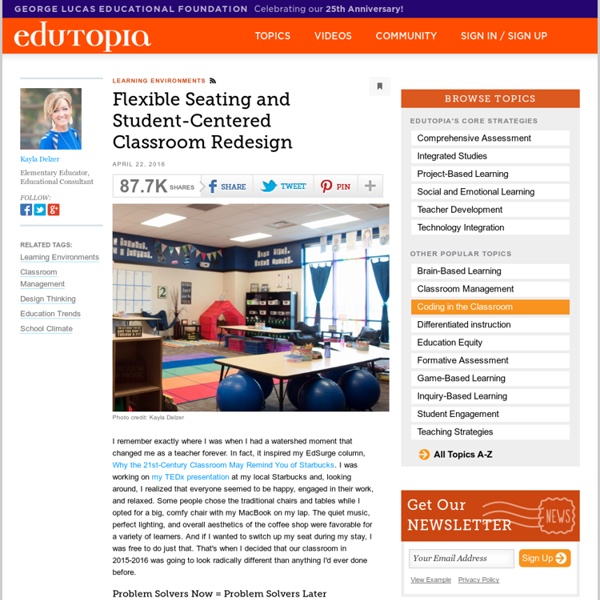Managing and Motivating Math Minds with Kacie Travis: Eight Things That Should be at the Top of Teachers' To-Do Lists for the Beginning of the Year
I am a list-maker. BIG TIME. I love the feeling of crossing a completed task off of my to-do list and watch the crossed off items overpower the unfinished work. I have lists everywhere, for every thing. 1. What is the most effective way to arrange the desks? 3. 4. 5. 6. 7. 8. I sincerely wish you the best school year ever.
Classroom Management Strategies for Difficult Students
Teachers in middle level schools face overwhelming demands and challenges in their classrooms. They are expected to know content and pedagogy, develop engaging lessons that meet the needs of diverse learners, and use a variety of instructional strategies that will boost student achievement while they simultaneously develop positive relationships with, on average, 125 students each day who are experiencing the personal, social, and cognitive challenges and opportunities of early adolescence (Carnegie Council on Adolescent Development, 1995; Schmakel, 2008). Teaching is complex and cannot be reduced to discrete tasks that can be mastered one at a time. How can teachers engage students through enhanced personal interactions while simultaneously managing classroom climate and instruction? Classroom management and relationship building One of the keys to effective classroom management is the development of a quality relationship between the teacher and the students in the classroom. Dunn, N.
Möblering för effektiv språkundervisning – pedagogfredrik
Det finns många viktiga aspekter att väga in när man planerar en effektiv språkundervisning. IKT, läromedel, metodik etc. En faktor som är bland det viktigaste är just utformningen av klassrummets fysiska arbetsmiljö – möbleringen. Jag har just lämnat en tjänst som lärare i franska i åk 7-9 på Frösåkersskolan i Östhammar, till förmån för en ny tjänst jag fått. En sak som jag saknar, förutom mina elever, är just mitt ämnesrum som jag hade i franska (se bilden). Om vi bortser från det felaktiga formatet av den schweiziska flaggan så är jag väldigt stolt över rummet. Eleverna har ögonkontakt med varandra (bortsett från någon enstaka tokig vinkel), vilket underlättar när vi tränar talförmågorna.Vid bordet i mitten sitter jag. Vid det runda bordet sitter jag. Like this: Like Loading...
5 Quick Classroom-Management Tips for Novice Teachers
I made a good number of blunders my first year teaching that still make me cringe. I learned though. And it's fair to say, when it comes to managing a classroom, most of what we learn as new teachers is trial by fire. #1 Use a normal, natural voice Are you teaching in your normal voice? Raising our voice to get students' attention is not the best approach, and the stress it causes and the vibe it puts in the room just isn't worth it. You want to also differentiate your tone. #2 Speak only when students are quiet and ready This golden nugget was given to me by a 20-year veteran my first year. So I tried it; I fought the temptation to talk. My patience paid off. #3 Use hand signals and other non-verbal communication Holding one hand in the air, and making eye contact with students is a great way to quiet the class and get their attention on you. Flicking the lights off and on once to get the attention is an oldie but goodie. #4 Address behavior issues quickly and wisely
ledarskaps och samarbetsövningar - Hem och Skola
Med ledarskaps- och samarbetsövningar menar vi lekar och övningar som utvecklar den sociala gemenskapen. En god gemenskapskänsla i klassen inverkar på hur man trivs i skolan. Genom olika lekar och övningar som stöder samarbete kan man leda gruppen mot en bra samhörighet och ”vi-känsla”. Eleverna lär sig att samarbeta, utrycka känslor och ta hänsyn till andra. Spindelnätet Varför? Vad behövs? Hur? Källa? Ställa sig i en ring och sätta sig i varandras famn Vad behövs? Hur? Mingelbingo Varför? Vad behövs? Hur? Hur lika/olika är vi Varför? Vad behövs? Hur? Placeringsleken Varför? Vad behövs? Hur? Knuten Varför? Vad behövs? Byta namn leken Hur? Källa? Hinderbana Varför? Framåt marsch! Varför? Kameran Varför?
The Only Classroom Rules You'll Ever Need
If you’re looking for elaborate or decorative classroom management ideas, you won’t find them here. Though prevalent, such ideas are unnecessary, even counterproductive, for classroom management. On this site, we’re focused on only two things: 1. What works best. 2. The goal of classroom management is to eliminate distractions, disruptions, and poor behavior, so you are free to inspire your students. The results are happy and high achieving students. Anything that interferes with this goal, or doesn’t contribute to it, should be thrown out. Too many teachers chase the next great classroom management idea and are continually disappointed. In the meantime, they’re stressed and tired of dealing with behavior issues. An act of joy. So instead of chasing trends, why not focus on what is proven to work? And, most important, you’ll be able to focus your energies on what attracted you to teaching in the first place: the chance to make a lasting impression on your students. 1. 2. 3. 4. But they work. 1.



